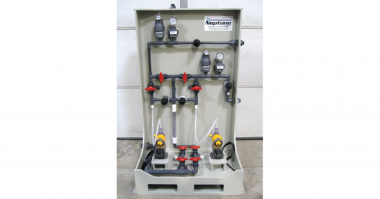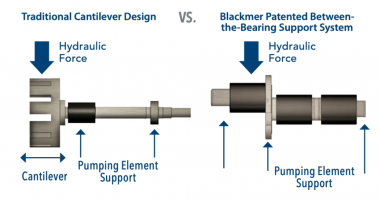Author: Kevin Hogue
Most of us recognize the hulking industrial facilities that are known as power plants, with their rows of cooling towers that allow the waste heat energy, in the form of water vapor, that is a byproduct of the power-generation process to be vented to the atmosphere. The interior of a power plant is just as daunting, with a series of pumps, clarifiers and filters used to transfer common water from a river, lake or aquifer into the ultra-pure water that will be sent through a boiler that converts that water into the steam that drives the turbines to create the electricity that is used to power thousands of homes and businesses.
Ensuring that the proper doses and flow rates of the chemical compounds, such as ferric sulfate and sulfuric acid, that are used to purify the water are reliably achieved is a key concern for the power-plant operator. The purification of the water that is needed for power generation occurs through a number of specific operational stages. The first is the water’s passage through a clarifier, where any large, solid impurities are removed. From there, the water travels through a filter, where any dissolved solids (not visible to the naked eye) are removed. These initial pre-treatment stages are critical because from there the water moves through a demineralizer, which cannot handle water that contains any solids.
The ferric sulfate is used in the clarifying and filtering stages of power generation. Since it is a coagulant, it interacts with any solid particles in the water and causes them to “clump” together, which makes it easier for the particulates to be removed from the water. The sulfuric acid is used in the demineralization process as way to balance the pH level of the water so that it achieves that “neutral” state that is required before it can be heated.
Though thousands of gallons of water are going through the clarifiers, filters and demineralizers on an hourly basis, the amount of ferric sulfate and sulfuric acid that is introduced to the process must be precisely controlled. In other words, if the process calls for 2.5 gallons per hour (gph) of ferric sulfate to be used, that means it has to be 2.5 gph, not 2.4 or 2.6 gph. The same goes for the doses of sulfuric acid that are required.
Over the years, hydraulically actuated diaphragm metering pumps have been proven to possess the operational capabilities and reliability to perform crucial ferric sulfate and sulfuric acid dosing operations. Metering pumps are perfect for these applications because they can be dialed in to meet specific flow and dosage parameters, which are the lifeblood of a power plant’s water-purification process.
For more information on the use of metering pumps in power generation applications, please download this white paper.
Within the realm of the metering-pump universe, the standout technology is the 500 Series Hydraulically Actuated Diaphragm Metering Pump from Neptune™ Chemical Pump Company, North Wales, PA, USA, a product brand of PSG®, Oakbrook Terrace, IL, USA, a Dover company.
The Neptune 500 Series pumps separate themselves from the competition because they feature a design with a unique Variable Oil By-pass™ stroke adjustment that gives the valve checks extra time to seat and allows better valve performance than competitive variable-linkage designs. Desired flow rates are achieved through the incorporation of a highly accurate 10-turn micrometer dial that can be calibrated to 1% increments. All pump sizes in the Neptune 500 series have a repeatable accuracy of +/- 1% of full scale over the range of 10% to 100% of capacity.
For power-plant operations that may require higher pumping pressures, Neptune offers the 6000 Series Hydraulically Actuated Diaphragm Pump, which can produce pressures up to 4,000 psi (276 bar). The 6000 Series pumps also offer all of the standard-setting features of the 500 Series models.
We are always interested in hearing about any equipment-related successes you have had in any of your operations. If there are any recent instances where an industrial pump system has helped optimize your fluid-handling capabilities, please email me at kevin.hogue@psgdover.com.




